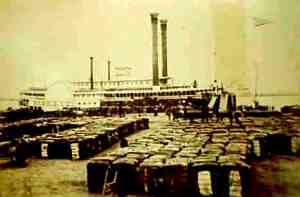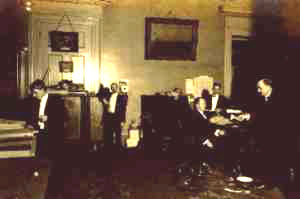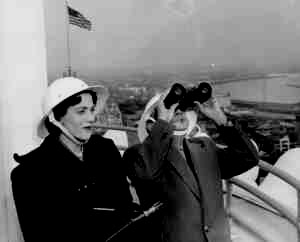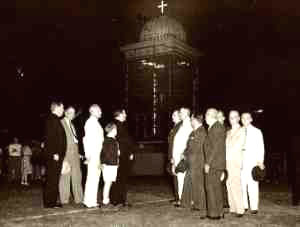


| 
|
| The Palm Gardens, on the second floor of the St. Charles Hotel, 211 St. Charles Avenue, ca. 1900. The room was in the third St. Charles Hotel, two earlier equally sumptuous structures of that name having burned to the ground at that same address. The photograph reminds us that luxury hotels are not a recent innovation in New Orleans. A 1903 advertisement for the St. Charles reads: "The largest and one of the best hotels in the country. With accommodations for more than one thousand guests. Strictly fireproof. Famous for its promenade, palm gardens, Turkish Baths and other luxurious appointments." The building was torn down in 1974 to make room for what is now one of the city's tallest buildings, the First NBC Center, until recently known as Place St. Charles. [Louisiana Photograph Collection. Glass Slide Collection] | Crockery Department, D.H. Holmes, ca. 1900. Daniel Henry Holmes opened his store at 114 Canal Street in 1846 and over the years, Holmes became an institution to generations of New Orleanians. Holmes was sold to the Dillards Department Store chain in 1989, and the new company donated the building to the city and left Canal Street. But the Holmes building has recently found a new life as the Chateau Sonesta Hotel, developed by Historic Restoration, Inc. in partnership with the City of New Orleans. [Louisiana Photograph Collection. Glass Slide Collection] |

| 
|
| Mannessier's Pavilion, West End, ca. 1900. The New Basin Canal reached the Lake at West End, a resort area that flourished from the 1880s to around 1920. New Orleanians rode steam and later electrified trains or took the Shell Road to the site, where there were restaurants, amusement rides, musical entertainment, and movies shown outdoors. Mannessier's, at right, was a branch of Mannessier's Confectionery, a famous coffee, ice cream and pastry shop on Royal Street. The pavilion operated at West End from about 1899-1911. [Louisiana Photograph Collection. C. Milo Williams Collection] | Steamboats unloading at the New Orleans levee, ca. 1890. A few steamboats remain on the Mississippi now, but only to serve the tourist trade; once they were the life-blood of the Crescent City. [Louisiana Photograph Collection. George Francois Mugnier Collection] |

| 
|
| Mayor Martin Behrman leaves his office at City (Gallier) Hall, 5 p.m., ca. 1910. This is the last in a series of twenty-five photographs taken by John Hypolite Coquille, a staff photographer for the Times-Democrat, illustrating a "typical" day in the Behrman administration. Coquille follows the Mayor from his doorstep in Algiers, across the river on the ferry, to inspections of city works in progress, through meetings with city officials, dignitaries, and citizens, and so to the end of the day. In its basic structure, if not in its intensity, perhaps Mayor Behrman's day was not so different from the current Mayor's. Mayor Morial, however, does not have a spittoon on the floor in his outer office! [Louisiana Photograph Collection. Behrman Album] | The first Athenaeum, St. Charles Avenue and Clio Street, built for the Young Men's Hebrew Association in 1896. The YMHA sponsored lectures, art shows, and rented the space for masquerades, cotillions, and other private entertainments. This building burned in January 1905 and was replaced in 1907 by the "New" Athenaeum on the same site, the scene of many Carnival balls until the early 1930s. The new Athenaeum also burned, in 1937. The corner is now the site of the Orleanian Apartments. Today, one of the hubs of Jewish cultural and recreational activity is the Jewish Community Center on the corner of Jefferson and St. Charles Avenues. [Louisiana Photograph Collection. C. Milo Williams Collection] |

| 
|
| This photo recalls the "red scare" of the Cold War era. These are "ground observers," civilian volunteers trained by the Office of Civil Defense to spot enemy invaders, photographed atop the Hibernia Bank building in February, 1955. Throughout the 1950s and 1960s, Civil Defense maintained an active program to instruct citizens in procedures to follow in the event of nuclear attack. Fallout shelters were designated throughout the city, including the basements of the new City Hall and the new Main Library (where fallout shelter signs can still be seen). The city installed an elaborate warning system of 76 large sirens and even built a fully equipped command center from which city officials could "safely" direct the operations of rescue and salvage following an attack. The bunker remains on the neutral ground between West End and Pontchartrain Boulevards, abandoned now, along with the fears that pervaded the 50s and 60s. [Louisiana Photograph Collection. Municipal Government Collection; Office of Civil Defense Series] | The visit of Pope John Paul II to New Orleans in 1987 was an unforgettable event in the lives of Roman Catholic New Orleanians. The Pope's outdoor mass on the Lakefront attracted a crowd of some 130,000 faithful. But earlier, New Orleans had also hosted another important Catholic gathering. The Eighth National Eucharistic Congress, held in New Orleans from October 17 to 20, 1938, was an international meeting of Roman Catholic clerics and lay people that drew more than 65,000 people to the recently opened City Park Stadium. Shown fifth from left in this photo of the altar erected for the event is Archbishop Joseph Francis Rummel. [Louisiana Photograph Collection. Robert S. Maestri Collection] |

| 
|
| What better way to remember the history of the St. Charles Streetcar line than with an old spike from the tracks running in front of the Inter-Continental Hotel. [City Archives. Mayor Sidney J. Barthelemy Records] | The New Orleans levee following the great hurricane of 1915. The category 4 storm struck suddenly on September 29, leaving 275 people dead in its wake along the Gulf Coast and severely damaging more than 25,000 of the city's buildings. The port of New Orleans was especially hard hit, as this photograph indicates. It reminds all of us who live in this below sea level city of our vulnerability to Mother Nature's wrath and of how lucky we've been in recent years to escape the big one that we all fear will strike us sooner or later. [Louisiana Photograph Collection. David Barrow Fischer Steamboat Collection] |

Many of us are familiar with the history of Irish Channel churches during the antebellum
period when separate places of worship existed for the German, Irish, and French segments of the
neighborhood's population. The German church, St. Mary's Assumption, is still in use, while the Irish
facility, St. Alphonsus, remains standing but is no longer consecrated. This postcard, from the early
part of this century, is one of our few remaining memories of the old French church on Jackson
Avenue, demolished earlier this century. [Louisiana Postcard Collection: Churches]
| |
Return to Beginning of Exhibit